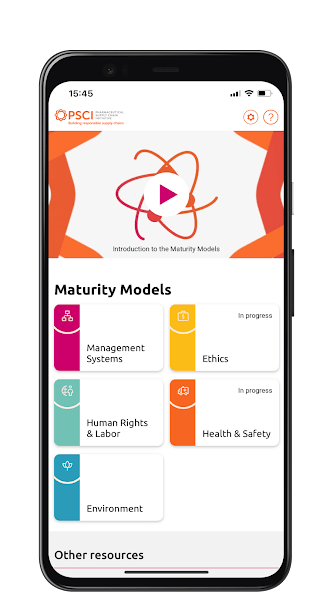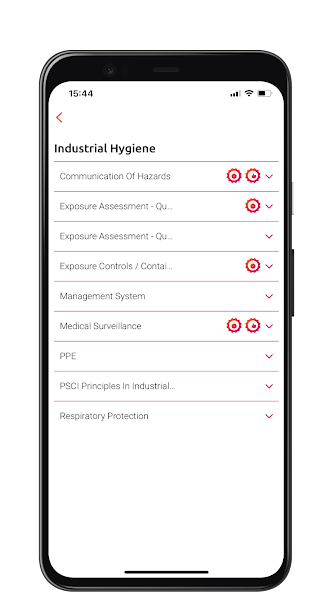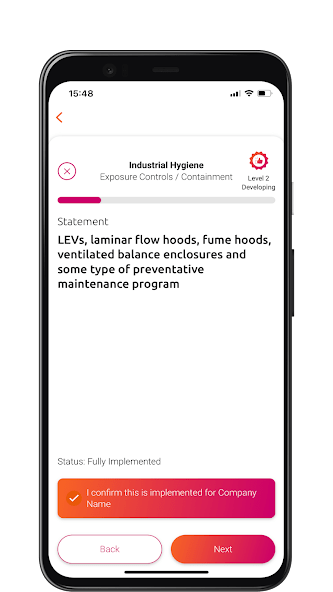This resource was published on 7 February 2019
WORD VERSION
Abbreviated PSCI Self Assessment Questionnaire & Audit Report Template for Service Providers & General Manufacturers
Version 5, February 2019
Version 6, remote audit options added, October 2020
Since 20 April 2022, the Word versions of the templates (Full, Abbreviated, CAPR) have been removed completely following a consultation process and notice period. Access to these is only be possible in exceptional circumstances and by contacting the PSCI Secretariat. Please use the Excel versions: Full, Abbreviated, CAPR
-
Ethics
-
Human Rights & Labor
-
Health & Safety
-
Environment
-
Management Systems
-
Audit Program
This resource was published on 14 November 2018
This PSCI Audit Sharing Platform User Guide explains how to use the Audit Sharing Platform for members. The platform underpins the PSCI Audit Sharing Program. It is the platform for sharing audits with the PSCI membership.
Please refer to the PSCI Shared Audit Program Guidance for more information about the PSCI Audit Sharing Program.
This resource was published on 14 November 2018
This document is designed to be used by PSCI members, audit contractors and suppliers. It provides a detailed overview of the audit process and corresponding roles and responsibilities at each stage of the process.
Version 8, November 2025
Updated to align with the updated PSCI Principles and Strategy, inclusion of the digital Data Sharing via the PSCI Audit Platform, updated audit uploading requirements for full members, introduced online SAQ and removed reference of word version template, referenced the Audit Checklist as a separate resource in Chapter 10 and added section on Managing Audit Related Issues in the appendix.
This resource was published on 28 October 2018
These slides were shown as part of a Auditor Training webinar, which can be found here.
This training was delivered in September 2018.
This resource was published on 26 October 2018
This PSCI webinar is a training video for auditors. This was recorded in September 2018.
The slides shown in this webinar can be found here.
This resource was published on 21 September 2018
Day 2 presentation pack from the 2018 Supplier Conference in Shanghai, China.
This resource was published on 21 September 2018
Day 1 presentation pack from the 2018 Supplier Conference in Shanghai, China.
-
Ethics
-
Human Rights & Labor
-
Health & Safety
-
Environment
-
Management Systems
-
Pharmaceuticals In The Environment
-
Anti-Microbial Resistance
This resource was published on 1 August 2018
This is the agenda for 2018 PSCI India Supplier Conference.
This resource was published on 26 July 2018
This is recording of the PSCI sponsored webinar on evaluating supplier ethics and compliance practices and programs which took place on 25th July 2018.
This resource was published on 26 July 2018
This is the slide deck from the PSCI sponsored webinar on evaluating supplier ethics and compliance practices and programs which took place on 25th July 2018.
This resource was published on 26 July 2018
This is the agenda for 2018 PSCI China Supplier Conference.
This resource was published on 11 July 2018
This is the slide deck from the PSCI sponsored webinar on how to manage APIs in manufacturing effluent (Part 4) which took place on 10th July 2018.
The webinar gave a brief refresher on Pharmaceuticals in the Environment (PiE), Anti-Microbial Resistance (AMR) and Predicted No-Effect Concentration (PNEC) first principles, and introduced a PSCI resource page where PNECs can be found. It also included step-by-step guidance on how to locate PNECs and use them.
The webinar recording is available here.
-
Environment
-
Pharmaceuticals In The Environment
-
Anti-Microbial Resistance
This resource was published on 11 July 2018
This is recording of the PSCI sponsored webinar on how to manage APIs in manufacturing effluent (Part 4) which took place on 10th July 2018.
The webinar gave a brief refresher on Pharmaceuticals in the Environment (PiE), Anti-Microbial Resistance (AMR) and Predicted No-Effect Concentration (PNEC) first principles, and introduced a PSCI resource page where PNECs can be found. It also included step-by-step guidance on how to locate PNECs and use them.
The webinar slide deck is available here.
-
Environment
-
Pharmaceuticals In The Environment
-
Anti-Microbial Resistance
This resource was published on 11 July 2018
This document defines the PSCI member audit uploading requirement.
Refreshed in May 2025 to align with the audit uploading expectations in the updated PSCI Strategy 2024 - 2026.
This resource was published on 11 June 2018
The following are useful resources for obtaining PNEC values.
- AMR Industry Alliance Antibiotic Discharge Targets - List of Predicted No-Effect Concentrations (PNECs).
The PNEC table contains two values, PNEC‐Environment (PNEC‐ENV) values based on eco-toxicology and PNEC‐Minimum Inhibitory Concentration (PNEC‐MIC) values intended to be protective of resistance promotion.
The AMR Industry Alliance recommendation is that companies target the lower of these two values (when available) for assessing manufacturing site discharges under a risk‐based framework.
-
Pharmaceuticals In The Environment
-
Anti-Microbial Resistance
This resource was published on 19 March 2018
Inside the report, you will find highlights and achievements from 2017, a busy and important year for PSCI, and our plans for 2018.
This resource was published on 17 January 2018
This is a short summary of the new strategy, and the process taken to achieve it.
This resource was published on 22 November 2017
Presentation Pack from the 2017 PSCI Auditor Training, 20 - 22 November, in Shanghai, China.
This resource was published on 22 November 2017
Presentation Pack from the 2017 PSCI Auditor Training, 20 - 22 November, in Shanghai, China.
This resource was published on 22 November 2017
Presentation Pack from the 2017 PSCI Auditor Training, 20 - 22 November, in Shanghai, China.
This resource was published on 5 October 2017
Slides from the PSCI Audit Programme Webinar, Oct 2017
The webinar explained the supplier self-initiated audit model and launched the new Excel based audit templates.
This resource was published on 26 September 2017
This Excel template is designed to help PSCI members, suppliers and audit firms check auditors against the PSCI's requirements, to ensure that they have the expertise needed to conduct PSCI audits. It is also used by new audit firms in their application process to demonstrate their capacity.
This evaluation tool is also known as PSCI Auditor Information Template (HSE & Social Auditors).
Last updated March 2021.
This resource was published on 12 September 2017
PSCI Articles of Incorporation
This resource was published on 19 May 2017
2017 India Conference Presentation Pack Day 2
This resource was published on 19 May 2017
2017 India Conference Presentation Pack Early Bird Dekra
Chemical Hazard Assessment & Runaway Reactions
This resource was published on 19 May 2017
2017 India Conference Presentation Pack Early Bird PSCI Basics
This resource was published on 19 May 2017
2017 India Conference Presentation Pack Day 3
This resource was published on 19 May 2017
2017 India Conference Presentation Pack Day 1
This resource was published on 30 March 2017
Agenda for 2017 Supplier Conference in Hyderabad, India
This resource was published on 20 March 2017
Green Chemistry Pharma Week Photo Report February 2017
This resource was published on 20 March 2017
Presentation booklet from the 2017 PSCI Auditor Training, 28 Feb - 1 March, in Hyderabad, India
This resource was published on 14 February 2017
PSCI Auditor Training presentation deck from 2015
This resource was published on 30 November 2016
Day 2 presentation pack from the 2016 Supplier Conference held in Shanghai.
This resource was published on 30 November 2016
Day 1 presentation pack from the 2016 Supplier Conference held in Shanghai.
This resource was published on 26 October 2016
This is the slide deck for the PSCI sponsored webinar on how to manage APIs in manufacturing effluent (Part 3) which took place on 25th October 2016. The webinar looked at advanced technologies to reduce API loss with guest speakers from the Temple University WET Centre and AECOM.
-
Environment
-
Pharmaceuticals In The Environment
This resource was published on 20 June 2016
This is recording of the PSCI sponsored webinar on how to manage APIs in manufacturing effluent (Part 2) which took place on 15th June 2016. The webinar provided step-by-step guidance on this ‘spotlight’ issue for our industry and covered the following topics:
- estimating actual API losses from the manufacturing process (PEC)
- establishing the acceptable discharge concentration (PNEC)
- making low capital investment housekeeping steps to reduce the loss of APIs
The webinar's slide-deck is available here.
-
Environment
-
Pharmaceuticals In The Environment
This resource was published on 20 June 2016
This is the slide deck for the PSCI sponsored webinar on how to manage APIs in manufacturing effluent (Part 2) which took place on 15th June 2016. The webinar provided step-by-step guidance on this ‘spotlight’ issue for our industry and covered the following topics:
- estimating actual API losses from the manufacturing process (PEC)
- establishing the acceptable discharge concentration (PNEC)
- making low capital investment housekeeping steps to reduce the loss of APIs
The webinar recording is available here.
-
Environment
-
Pharmaceuticals In The Environment
This resource was published on 3 February 2016
This is the slide deck for the PSCI sponsored webinar on how to manage APIs in manufacturing effluent which took place on 27th January 2016. The webinar provided step-by-step guidance on this ‘spotlight’ issue for our industry and covered the following topics:
- Why is managing active pharmaceutical ingredients (API) in manufacturing effluent important?
- What is the industry doing to improve public perceptions?
- Understanding where you stand at the moment through the maturity ladder concept.
- Establishing and calculating API discharge concentration called the Predicted-No-Effect-Concentration (PNEC).
- Simple steps to reducing API process losses to waste water and what to do when the PNEC is exceeded.
- How to advance your program to the next level.
The webinar recording is available here.
-
Environment
-
Pharmaceuticals In The Environment
This resource was published on 3 February 2016
This is a recording of the PSCI sponsored webinar on how to manage APIs in manufacturing effluent which took place on 27th January 2016. The webinar provided step-by-step guidance on this ‘spotlight’ issue for our industry and covered the following topics:
- Why is managing active pharmaceutical ingredients (API) in manufacturing effluent important?
- What is the industry doing to improve public perceptions?
- Understanding where you stand at the moment through the maturity ladder concept.
- Establishing and calculating API discharge concentration called the Predicted-No-Effect-Concentration (PNEC).
- Simple steps to reducing API process losses to waste water and what to do when the PNEC is exceeded.
- How to advance your program to the next level.
The webinar slide-deck is available here.
-
Environment
-
Pharmaceuticals In The Environment
This resource was published on 1 February 2016
This PSCI Audit Sharing Platform User Guide explains how to use the Audit Sharing Platform for suppliers. The platform underpins the PSCI Audit Sharing Program. It is the platform for sharing audits with the PSCI membership.
Please refer to the PSCI Shared Audit Program Guidance for more information about the PSCI Audit Sharing Program.
This resource was published on 20 January 2016
Abstract: This Caldwell et al. study describes guidance intended to assist pharmaceutical manufacturers in assessing, mitigating, and managing the potential environmental impacts of active pharmaceutical ingredients (APIs) in wastewater from manufacturing operations, including those from external suppliers.
-
Environment
-
Pharmaceuticals In The Environment
This resource was published on 6 January 2016
This document explains the PSCI membership fees structure and the Supplier Partnership fee.
New version added: October 2024
This resource was published on 14 October 2015
Full presentation pack from the 2015 Supplier Conference held in Mumbai, India.
This resource was published on 9 July 2015
PowerPoint on the fundamentals of industrial hygiene.
-
Health & Safety
-
Occupational Health & Industrial Hygiene



